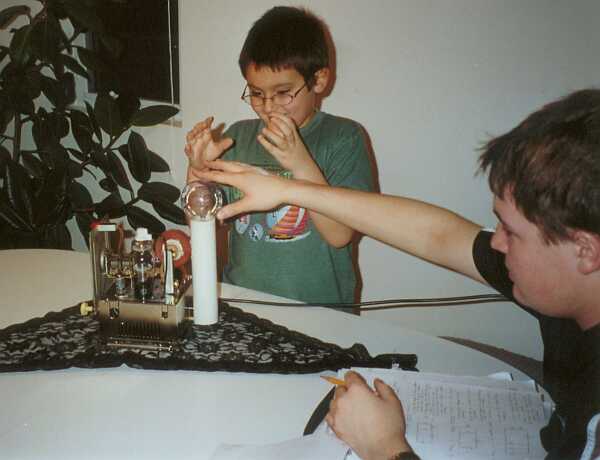
4: CARE AND FEEDING
My build of "G'Zot!" is semi-permanently installed on the front counter at my place
of work, a two-way radio shop. It has already amazed and amused virtually everyone who enters
the shop, and has been well worth the effort just to see the range of reactions. An
amusing sign in front of the unit also gets smiles and chuckles.
Kids and young people especially gravitate towards displays of this kind, so it's very important
to make it safe, and allow use only under supervision. Be especially sure to use a polarised
power plug, so that there is no possibility of having a hot chassis. Also insure that your
house or other building is wired properly! Take the effort to insulate all exposed transformer
taps and other contact points. The output lead going to the plasma globe should be carefully
and thoroughly insulated using a piece of PVC pipe or similar insulator, as in the pictures.
(While the output doesn't have enough current to electrocute, especially since at these high
frequencies most conduction is on the surface, the arc can still give nasty little RF burns).
The globe can be soldered to the output with a short length of wire, then glued to the top of
the insulator column with Krazy Glue or RTV silicone.

G'Zot! handily lights up flourescent tubes "remotely". Hold one end of the tube and
bring the other end near to the plasma globe or flyback transformer. Or hold a small NE-2 neon
bulb and bring it close to the plasma globe.
You can make it into a Jacob's Ladder, if you prefer. See
here for more
information on this. (See especially the bit about the
"Gabriel Gap" or tickler
to help the arc to strike initially.) Stainless steel rods (e.g. pieces of a radio whip
antenna) are an excellent choice of material. Unfortunately, G'Zot! isn't quite capable of
enough current to make a very reliable Jacob's Ladder, the arc tends to hang up at the bottom
for extended periods of time. However, a slight puff of air usually gets it cycling again.
If you're into audio, you can use G'Zot! to experiment with arc tweeters. Set it up to produce
a constant arc between two pointed pieces of stainless steel rod, and inject your audio
signal into the screen of the output tube via a coupling capacitor. Where is the sound coming
from? You may wish to experiment with horn assemblies to amplify and focus the sound. (But
be careful, that arc can easily set things on fire!)
END OF ARTICLE





